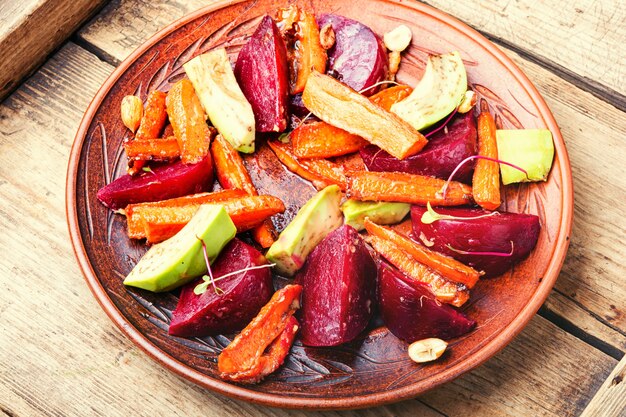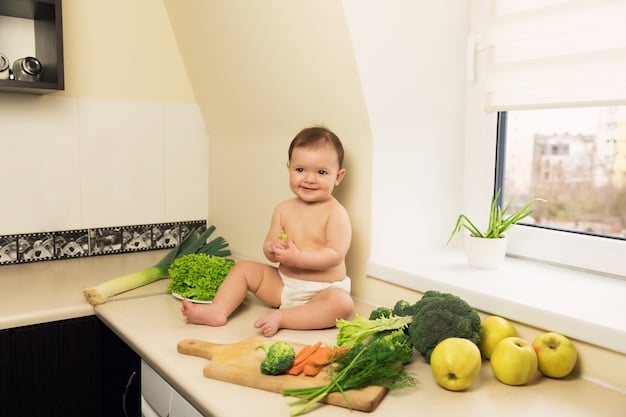Baby-Led Weaning for Picky Eaters: Your Complete Guide

Baby-led weaning (BLW) offers a fantastic approach to introducing solids to babies, even those with picky tendencies, by allowing them to self-feed and explore different textures and tastes at their own pace, fostering a positive relationship with food from the start.
Starting solids can be a daunting task, especially when you have a picky eater on your hands. But what if there was a way to make mealtime more enjoyable and less stressful for both you and your baby? Baby-led weaning for picky eaters is a method that promotes self-feeding from the very beginning, allowing your little one to explore a variety of flavors and textures at their own pace.
What is Baby-Led Weaning and Why Choose It?
Baby-led weaning (BLW) is an approach to introducing solid foods where babies feed themselves whole foods from the start, rather than being spoon-fed purees. This allows them to control what and how much they eat, fostering independence and developing fine motor skills. Choosing BLW can be especially beneficial for picky eaters, but why?
Benefits of Baby-Led Weaning
BLW offers numerous advantages. It encourages babies to explore different flavors and textures, helping them develop a more diverse palate. Additionally, it promotes independence and self-regulation of food intake, which can reduce the likelihood of overeating later in life.
Addressing Picky Eating with BLW
While some parents worry that BLW might exacerbate picky eating, it can actually have the opposite effect. By allowing infants control over what they put in their mouths, BLW can alleviate anxiety related to food and create more positive mealtime experiences. This hands-on approach allows your baby to become familiar with lots of different food, in their own way. Here are some more specific points:
- Encourages Exploration: Babies can explore the taste, texture, and smell of various foods.
- Reduces Mealtime Stress: By allowing self-feeding, it removes the pressure of spoon-feeding.
- Develops Fine Motor Skills: Grasping and bringing food to the mouth enhances hand-eye coordination.

Research supports the benefits of BLW, noting its positive impact on motor skills and dietary variety. Studies have shown that babies introduced to solids through BLW often exhibit a broader acceptance of different foods later in toddlerhood. A study in the journal “Pediatrics” highlights the importance of early exposure to a variety of textures in preventing picky eating habits. Overall, baby-led weaning can be a positive approach, helping your child take the reins when it comes to their diet.
Getting Started with Baby-Led Weaning: A Step-by-Step Guide
Starting with baby-led weaning requires some preparation and understanding of the basics. It’s not just about putting food in front of your baby; it’s about offering appropriate foods safely and supporting your baby’s learning process. Here’s a step-by-step guide to help you get started.
Preparing for Baby-Led Weaning
Before you begin, ensure your baby is ready for solids. This typically occurs around six months of age, when they can sit upright with minimal support, have good head control, and show interest in food. Consult your pediatrician to confirm that your baby is developmentally ready.
Safe Food Preparation
Food safety is paramount. Offer foods in sizes and shapes that are easy for your baby to grasp and won’t pose a choking hazard. Soft-cooked vegetables, strips of meat, and wedges of fruit are good starting points. Always avoid small, round foods like whole grapes or cherry tomatoes.
Consider these points when beginning:
- Cut food into finger-sized strips or spears.
- Cook vegetables until they are soft and easily squished.
- Remove any bones, seeds, or tough skin.
First Foods to Try
Start with single-ingredient foods to identify any potential allergies. Avocado, sweet potato, banana, and steamed broccoli are excellent choices. Introduce one new food every few days to monitor for reactions.

Remember, the goal is exploration, not consumption. Your baby may only mouth or play with the food initially. Don’t be discouraged; this is a natural part of the learning process. While beginning, it’s important to remember that exposure can take time and repetitions. Experts recommend repeated exposure to a food up to 10-15 times to help your child’s acceptance. Try to let your baby set the pace for the process and offer a varied range of fruits, vegetables, and proteins to help your child explore new things and develop their fine motor skills.
Addressing Common Concerns with Picky Eaters and BLW
Many parents have concerns when introducing baby-led weaning, especially if they anticipate picky eating habits. It’s normal to worry about whether your baby is getting enough nutrients or if they’ll only eat certain foods. Let’s address some common concerns and how to manage them effectively.
Nutrient Intake Worries
One of the primary concerns is whether babies are getting enough nutrients solely through self-feeding. Breast milk or formula should continue to be their primary source of nutrition until around 12 months. BLW is about exploration and developing skills, not replacing milk or formula. Always consult with your pediatrician or a registered dietitian to ensure your baby’s nutritional needs are met.
Dealing with Food Refusal
It’s common for babies to refuse certain foods or go through phases where they only want to eat one thing. Don’t pressure your baby to eat. Instead, continue offering a variety of foods and let them choose what they want to explore. Keep mealtime positive and relaxed.
Tips for Encouraging Picky Eaters with Baby-Led Weaning
Encouraging picky eaters to explore new foods through baby-led weaning requires patience and creativity. Here are some tips to make the process more successful and enjoyable for both you and your baby.
Make Mealtime Fun and Engaging
Create a positive mealtime environment by eating with your baby and making it a social activity. Talk about the foods you’re eating, describe their flavors and textures, and show your own enjoyment. Avoid distractions like screens or toys, and focus on creating a pleasant experience.
Offer a Variety of Foods
Continuously expose your baby to a range of foods, even if they initially refuse them. Offer different colors, textures, and flavors to stimulate their senses and encourage exploration. Don’t give up on a food after one or two attempts; it can take multiple exposures before a baby accepts a new food.
Here are some creative ways to engage your little one:
- Create colorful plates with a variety of options.
- Cut food into fun shapes using cookie cutters.
- Involve your baby in meal preparation (e.g., washing vegetables).
Remember that every baby is different, and what works for one may not work for another. Be patient, flexible, and celebrate small victories. Over time, your baby will likely become more adventurous and develop a broader palate as they continue to explore the joys of self-feeding.
Foods to Introduce Based on the Age of the Baby
Knowing what foods to introduce at what age can aid your baby’s development toward consuming solids. Starting around six months, you can introduce a variety of soft, easy-to-grasp foods, gradually expanding the range as your baby gets older. This guide will help you navigate the best options at each stage.
6-9 Months
At this stage, focus on single-ingredient foods that are soft and easy to digest. Good choices include:
- Avocado: Soft and packed with healthy fats.
- Sweet Potato: Cooked until soft and cut into strips.
- Banana: Easy to mash and hold.
- Broccoli: Steamed until tender.
9-12 Months
As your baby becomes more skilled at self-feeding, you can introduce a wider variety of foods and textures. Try:
- Chicken: Shredded or cut into small pieces.
- Pasta: Cooked until soft and easy to grasp.
- Lentils: Soft and easily digestible.
- Eggs: Scrambled or hard-boiled and sliced.
Safety Tips for Baby-Led Weaning
While baby-led weaning offers many benefits, safety should always be a top priority. Understanding potential choking hazards and knowing how to respond in an emergency are essential for a smooth and stress-free experience. Here are some crucial safety tips to keep in mind.
Choking Hazards and Prevention
It’s important to differentiate between gagging and choking. Gagging is a normal reflex that helps babies move food forward in their mouths. Choking, on the other hand, occurs when the airway is blocked. Avoid foods that are common choking hazards, such as whole grapes, nuts, popcorn, and hard candies.
Supervision and Emergency Preparedness
Always supervise your baby during mealtime. Never leave them unattended while they are eating. Learn basic first aid and CPR for infants, and know how to respond if your baby starts to choke. Consider taking a baby first aid course to gain confidence.
How to handle allergies
When beginning with baby-led weaning, follow common guidelines around allergies. Introduce new foods one at a time, every 2-3 days, to monitor for a reaction. Common allergens include peanuts, eggs, milk, soy, wheat, fish, and shellfish. If there’s a family history of allergies, consult with your pediatrician before introducing these foods. If you notice any signs of an allergic reaction, such as hives, swelling, or difficulty breathing, seek immediate medical attention.
| Key Point | Brief Description |
|---|---|
| 👶 Introduction Age | Around 6 months, when baby can sit up and shows interest in food. |
| 🥕 Safe Foods | Soft-cooked vegetables, strips of meat, and wedges of fruit. |
| ⚠️ Choking Hazards | Avoid whole grapes, nuts, popcorn, and hard candies. |
| 🍽️ Mealtime | Make it fun and engaging; eat with your baby and talk about the food. |
Frequently Asked Questions
▼
Yes, BLW can be beneficial for picky eaters. It allows babies to explore food at their own pace, reducing pressure and anxiety around mealtime, allowing for a more positive experience.
▼
Continue to offer a variety of foods without pressuring your baby to eat. It may take multiple exposures before they accept a new food, let them guide the pace.
▼
Breast milk or formula should remain the primary source of nutrition until 12 months. Consult with your pediatrician or a registered dietitian to ensure nutritional needs are met.
▼
Good starting points include avocado, sweet potato, banana, and steamed broccoli. Ensure they are soft and easy to grasp to eliminate a choking hazard.
▼
Avoid small, round foods like whole grapes and nuts. Cut food into finger-sized strips or spears, and always supervise your baby during mealtime to ensure safety.
Conclusion
Baby-led weaning for picky eaters can be a rewarding journey that fosters independence, develops fine motor skills, and encourages a positive relationship with food. With patience, creativity, and careful attention to safety, you can help your little one explore the world of flavors and textures with confidence. Enjoy this special time of discovery, and remember that every baby is unique, so adapt the process to suit your child’s individual needs and preferences.





